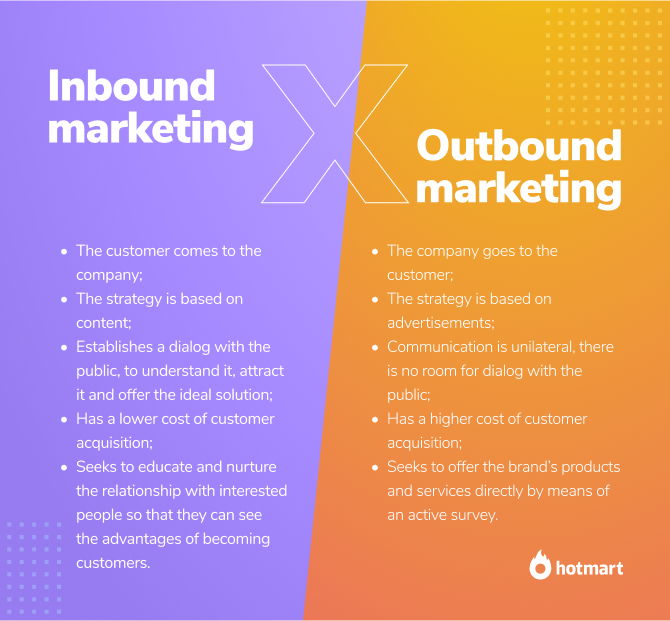
What Is the Difference Between Inbound and Outbound Marketing?
Do you know what the best advertising strategy is for your business?

The digital transformation we have seen over the last few years has brought about significant changes in how people discover businesses, relate to them, and consume their products and services.
If consumer behaviors have changed, marketing obviously also had to adapt to meet the new needs of consumers and continue to bring customers to the business.
With all this evolution, new concepts have also emerged, such as inbound and outbound marketing.
Understanding these two terms is essential for everyone working in the field, whether in traditional or digital marketing.
However, it is still common to find people who confuse inbound and outbound marketing or who do not quite understand what each one means.
To clear your doubts, we will explain in this text exactly what is inbound and outbound marketing and we will show you the differences between the two concepts.
Ready to learn?
What is inbound marketing?
To truly understand what inbound marketing is, it’s important to think about behaviors related to consumers that society is currently presenting.
If we observe closely, people are no longer interested only in acquiring products and services. What most people seek are solutions to their problems and needs.
Thus, marketing actions that focus only on advertising the products they offer no longer reach the public as efficiently as they used to.
This meant that promotion strategies had to be restructured to win over customers and guarantee sales.
Inbound marketing is the method that has arrived to meet this demand for a different way of communicating with the public. In inbound marketing, it is the customer that comes to the company, not the other way around.
Here, communication is done with attractive content that really adds value to people so they are interested in what the brand has to offer and feel comfortable starting a relationship with it.
View this post on Instagram
No wonder inbound marketing is also known as Attraction Marketing, after all, its main goal is to attract customers. Therefore, direct and invasive advertising for an audience that is not yet interested in the brand is not the goal of this advertising technique.
Inbound actions serve to nurture the relationship with the lead and make it advance on the buyer’s journey, increasingly recognizing the brand’s authority and the benefits it might have in becoming a customer.
If we are thinking of people who are looking for solutions, a company that invests in an inbound strategy should focus on relevant content that delivers something valuable to users. Thus, the chances of attracting truly interested people and encouraging them to start a dialogue become much greater.
What is outbound marketing?
The emergence of a new way of relating to the public does not mean that traditional marketing methods are either extinct or completely outdated.
Outbound marketing refers to a more targeted and even invasive way of advertising what the business has to offer its customers.
In an outbound strategy, it is the business that goes to the customer with its ads, and the goal is to generate an immediate desire.
Advertisements that are broadcast on TV and on billboards, printed in newspapers and magazines, or are telemarketing calls serve as good examples of outbound marketing.
At a time when people didn’t have access to so much information about companies and products, these were the only ways brands could reach their consumers.
However, with technological evolution and easy access to the internet, new ways of communicating with the public have emerged and, as we’ve said, people have become increasingly active in their choices.
However, even with so many changes, we are still exposed to all these traditional channels, right?
Although it is very common nowadays to say that this type of approach is outdated, it is still possible to reap good results with a good outbound strategy.
The important thing is to adapt this direct communication and to a large audience, to the new trends, which require creativity and in-depth knowledge of the desires of the people that need to be reached.
VIDEO: PAID OR ORGANIC TRAFFIC: Which is BETTER if you’re just GETTING STARTED? | Hotmart Tips
Similarities between inbound and outbound marketing
As you have seen above, inbound and outbound marketing are two methodologies in the marketing area.
Despite the many differences, which will be discussed in more detail below, the two forms of promotion also have certain features in common. After all, both relate to communication techniques between the company and the public, in other words, they are two ways to promote a brand, its principles, values, products, and services.
In addition, they have a common and final goal to attract customers to the company and thus increase sales and profit.
Differences between inbound and outbound marketing
To know how to use each of the methodologies, it is essential to understand what differentiates inbound and outbound marketing strategies.
As we mentioned earlier, in inbound marketing it is the customer who searches for the company after identifying with the content it shares and offers to people.
But, of course, the company doesn’t act passively in this relationship. It needs to invest in actions that are attractive to those it wants to reach; however, the potential customer is free to start the conversation with a brand.
In an outbound strategy, on the other hand, the brand is responsible for announcing and directly offering its products and services, in other words, it has to reach the customer, even though it has no prior knowledge of what it is and what it sells.
With regard to the language used, inbound, actions are directed to a more specific niche, which opens space for personalizing and segmenting communication. This ensures more closeness to the audience and consequently, more assertiveness.
In outbound marketing, the company talks to a wider audience, which limits personalization and calls for a somewhat more generalized approach.
Do you want a simple example of why this happens?
Let’s think of an ad that is broadcast during the commercial break of a network TV sitcom, for example.
There are thousands of people watching, so it is harder to segregate the communication and speak only to a limited and specific number of viewers.
In addition, time is short, so there is no way to nurture the relationship with those people and gradually draw them to the brand.
On social media or a blog for instance, users who access these channels are usually more specific since they have an affinity with what the brand shares and reached the channel while searching for something of interest.
If the brand invests only in the advertising and intrusive offers of its products and services, nothing prevents the user from leaving that channel and looking for another source of information to meet their needs.
Now do you understand what characterizes each methodology?
In short and simplifying, we will outline the main differences between inbound and outbound marketing:

Inbound and outbound marketing: which one is the best strategy?
If you got this far, you saw that there are two very distinct ways of promoting a business, each with its advantages and disadvantages.
Generally speaking, we can’t say that one strategy is better than the other because it all depends on the characteristics of your business, your goals, your resources and especially, the audience you need to reach.
Sometimes the right way is to use only one of the methodologies while there are businesses that use inbound and outbound marketing in a complementary way within their advertising strategy and are very successful in their actions.
If you are starting now, you will probably find that inbound marketing is the most appropriate. After all, this is a way to advertise your product without needing investments as high as those in outbound actions. In addition, you can start with strategies that really target your audience and initially involve only your participation, such as content marketing.
Investing in content is a way to convey authority in a particular area of operation, which is important both for online and physical businesses. And knowing how to plan and create the best content to meet the demands of your audience and convince them that you have the ideal solution.
Are you interested and want to learn more about the subject? Read our article What Is a Sales Funnel and How Do You Use It in Your Business? and understand how to use inbound and outbound marketing in each stage of the consumer’s journey.






